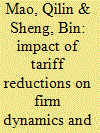|
|
|
Sort Order |
|
|
|
Items / Page
|
|
|
|
|
|
|
| Srl | Item |
| 1 |
ID:
188154


|
|
|
|
|
| Summary/Abstract |
The Regional Comprehensive Economic Partnership (RCEP) agreement was signed on November 15, 2020. This marks the formal conclusion of the world's largest free trade agreement in terms of population and economic scale. The RCEP agreement covers new liberalization commitments in goods, services, investment, and movement of natural persons, and addresses some emerging behind-the-border trade issues, to forge more transparent, open, and inclusive trade rules. Its aim is to build a comprehensive, modern, inclusive, and high-quality free trade agreement. This paper summarizes the framework and highlights of the RCEP agreement, measures the extent of tariff reduction from various perspectives, makes a quantitative assessment of the level of service trade liberalization of the member states adopting positive list commitments, and makes an in-depth analysis of trade rules and provisions in the RCEP agreement. Furthermore, this paper also makes a comprehensive comparison of main provisions among the Comprehensive and Progressive Agreement for Trans-Pacific Partnership, RCEP, and US-Mexico-Canada Agreement. The paper concludes with policy recommendations for China to promote the implementation of the RCEP agreement.
|
|
|
|
|
|
|
|
|
|
|
|
|
|
|
|
| 2 |
ID:
156465


|
|
|
|
|
| Summary/Abstract |
This paper investigates the impact of trade liberalization on firm dynamics and productivity in the context of dramatic tariff reductions after China's accession to the WTO, and how this impact varies across regions with different marketization levels. Our results show that (a) on average, output tariff reductions tend to reduce firm entry rate and increase firm exit rate, while input tariff reductions help to increase both firm entry rate and exit rate, furthermore, regional marketization strengthens the impact of trade liberalization on firm dynamics; (b) trade liberalization exerts greater impact on the likelihood of exit for the least productive firms while it tends to reduce the probability of exit for the more productive firms, with regional marketization strengthening such a reallocation process of trade liberalization; (c) firm dynamics effect contributes approximately 43% of the growth of productivity, and it (especially the firm exit effect) is an important channel through which trade liberalization fosters productivity growth, and domestic market reform is found to strengthen such an impact.
|
|
|
|
|
|
|
|
|
|
|
|
|
|
|
|
| 3 |
ID:
079061


|
|
|
|
|
| Publication |
2007.
|
| Summary/Abstract |
The Asia-Pacific Free Trade Area (FTAAP) has become a topic of focus since the proposal was first raised in 2004. The present paper considers China's policy towards the FTAAP from a political economy perspective by probing the gains, impediments and concerns for China, and makes judgments based on several possible scenarios. The author argues that from an economic perspective, China would benefit from joining the FTAAP both in a static and a dynamic manner because both its main trade partners and trade barriers in export markets are concentrated in the Asia-Pacific region. However, whether the Chinese Government is likely to support the initiative is largely dependent on certain crucial political and diplomatic elements, including the APEC approach, US-Chinese relations, quality of treaty, sensitive sectors, competitive proposal of alternative and membership of Chinese Taipei. Therefore, if the Chinese Government cannot ratify the ideology and terms of the initiative, or issues that are central to China's interests are not addressed, the FTAAP will only remain a proposal possessing economic possibility in the long run, without political feasibility in the near term
|
|
|
|
|
|
|
|
|
|
|
|
|
|
|
|
|
|
|
|
|